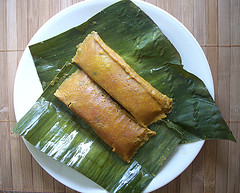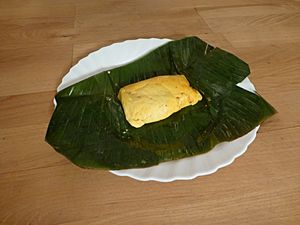Pasteles facts for kids

Puerto Rican pasteles
|
|
| Type | Dumpling |
|---|---|
Pasteles (pronounced pas-TELL-es) are a popular traditional dish found in many Latin American and Caribbean countries. You might also hear them called pastelles in places like Trinidad and Tobago. They are a type of dumpling that often looks like a tamale.
Pasteles are usually made from a dough (called masa) filled with meat, fish, or vegetables. This tasty filling is then wrapped in a banana leaf or parchment paper. After being wrapped, pasteles are typically boiled, steamed, or sometimes even grilled. They are a special food, especially enjoyed during holidays like Christmas.
Contents
Pasteles Around the World
Pasteles are made differently depending on where you are. Each country has its own special way of preparing this delicious dish.
Pasteles in Colombia
In Colombia, pasteles are known as pastel de arroz, which means "rice pastel." They are more like a tamale. These pasteles are made with rice that is seasoned and left to dry in the sun.
Many ingredients are mixed with the rice. Common additions include chorizo (a type of sausage), pork, chickpeas, olives, and potatoes. Sometimes, chicken and beef are also used. Colombian pasteles are wrapped twice. First, they get a cabbage leaf, and then a banana leaf on the outside. This dish is a traditional meal for Christmas Eve on Colombia's Caribbean coast.
Pasteles in the Dominican Republic
In the Dominican Republic, pasteles are a Christmas tradition. They were adopted from Puerto Rico. The Dominican version is often filled with ground beef and is known as "pasteles de hojas."
Another related snack is "Bollo de Guayiga." It is made from a root vegetable called Guayiga. You can find this snack on the southern beaches, especially near San Cristobal and Najayo Beach.
Pasteles in Hawaii
In Hawaii, pasteles are often called pateles. This name comes from the way people in Puerto Rico say "pasteles." Over 5,000 Puerto Ricans moved to Hawaii in the early 1900s. They came to work on sugar plantations.
Sometimes, people in Hawaii use the singular word pastel (or patel) even when talking about many. You might hear phrases like pastele stew or "baked pastele."
Pasteles in Puerto Rico
In Puerto Rico, pasteles are a very important food, especially during Christmas. The dough, or masa, is usually made from grated green banana, green plantain, white yautía (a root vegetable), potato, and tropical pumpkins called calabazas. It gets its flavor from liquid from the meat mixture, milk, and annatto oil.
The meat filling is prepared like a stew. It can have boston butt (pork shoulder), ham, bacon, raisins, chickpeas, pickled pimiento peppers, olives, and capers. Common seasonings include bay leaves, recaito (a mix of herbs), tomato sauce, and adobo seasoning. The filling can also be made with vegetables, poultry, fish, or other meats. Some modern recipes use roasted pork, with the bone removed to make a broth.
Traditionally, the masa was flavored with breadcrumbs and butter. Almonds were added to the filling, and a chili pepper was sometimes tucked into one end of each pastel. This chili tradition is thought to come from the Taíno people.
Making a pastel involves a large sheet of parchment paper and a banana leaf. The banana leaf is heated to make it soft. A little annatto oil is spread on the leaf. Then, the masa is placed on the banana leaf and filled with the meat mixture. The paper is folded and tied with string to make a packet. Some people use aluminum foil instead of parchment paper and string. Parchment paper is only used if the pastel will be boiled or steamed.
Once made, pasteles can be cooked in boiling water, steamed, or even smoked on a barbecue. They can also be frozen to cook later. Because they take a lot of work to make, large Puerto Rican families often make 50 to 200 or more at once, especially for the holiday season. Pasteles are often served with rice and pigeon peas (arroz con gandules), escabeche (pickled vegetables), and roasted pork.
Other Puerto Rican Pasteles
Pasteles de yuca are another popular type of pastel in Puerto Rico. The masa for these is made with cassava (yuca), yautía, sweet plantains, and squash. The cassava is grated and squeezed to remove most of its liquid. Broth, milk, butter, and annatto oil are added to the masa. These pasteles are filled with currants, chickpeas, olives, capers, seafood, meat, or poultry.
There are also pasteles de arroz. For these, the "masa" is made from partly cooked, seasoned rice. This rice finishes cooking when the pastel is boiled. Common fillings include pork, chicken, and crabmeat.
Pasteles are often served with ketchup, a spicy ketchup sauce, salsa rosada (a mix of ketchup, garlic, lime, and mayonnaise), ajilimójili, or pique criollo (a hot sauce).
Pasteles in Trinidad and Tobago
Trinidadian pastelles are small pies made from cornmeal. They are filled with meat, fish, or vegetables. These fillings are seasoned with fresh herbs and often include raisins, olives, and capers. Like other pasteles, they are wrapped and steamed in a banana leaf. They are a traditional food prepared and eaten during the Christmas season. It is believed that Spanish colonizers brought them to the islands between the late 1400s and early 1700s.
A sweet version of pastelles in Trinidad and Tobago is called paime. It is also a Christmas dish. Paime has no filling, but its dough contains ground coconut and raisins.
History of Pasteles
Pasteles are related to other dishes like alcapurria, tamales, hallacas, and guanimes. Some believe that the native people of Boriquen (Puerto Rico), called the Taínos, made early versions of these dumplings. The Taínos made dough from cassava, yautía, and squash. They filled it with beans, chilies, corn, nuts, meat (like lizards, frogs, or birds), or fish. Then, they wrapped it in corn husks.
The way pasteles are wrapped in banana leaves likely comes from the African ancestors of Puerto Ricans. These people were enslaved by the Spanish and forced to work on sugar plantations. In the early 1800s, enslaved African workers were given a simple diet that included plantains.
Puerto Rico has made pastel-making into an art form. There are hundreds of recipes, and the island even has an annual pastel festival called the Festival Nacional del Pastel Puertorriqueño.
See also
 In Spanish: Pasteles para niños
In Spanish: Pasteles para niños
Images for kids




